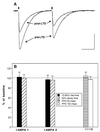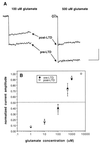The expression of cerebellar LTD in culture is not associated with changes in AMPA-receptor kinetics, agonist affinity, or unitary conductance
- PMID: 11707583
- PMCID: PMC61168
- DOI: 10.1073/pnas.241384598
The expression of cerebellar LTD in culture is not associated with changes in AMPA-receptor kinetics, agonist affinity, or unitary conductance
Abstract
Cerebellar long-term synaptic depression (LTD) is a model system of neuronal information storage that is expressed postsynaptically as a functional down-regulation of alpha-amino-3-hydroxy-5-methyl-4-isoxazolepropionic acid (AMPA) receptors. What properties of postsynaptic AMPA receptors are changed? Several lines of evidence argue against changes in AMPA-receptor kinetics. Neither LTD evoked in cultured granule-cell Purkinje cell (PC) pairs nor an LTD-like phenomenon evoked by phorbol ester application was associated with alterations in evoked AMPA receptor-mediated excitatory post-synaptic current (EPSC) or mEPSC kinetics. LTD produced by pairing glutamate pulses with depolarization was not altered by prior application of the desensitization-reducing compound cyclothiazide. Finally, rapid application of glutamate to lifted PCs revealed no significant alterations in AMPA-receptor kinetic properties after LTD induction. When this system was used to apply varying concentrations of glutamate, no alteration in AMPA-receptor glutamate affinity was seen after LTD induction. Finally, peak-scaled nonstationary fluctuation analysis was applied to estimate AMPA-receptor unitary conductance before and after LTD induction in a cultured cell pair, and this analysis too revealed no significant change. These results suggest that cerebellar LTD may be expressed solely as a reduction in the number of functional AMPA receptors in the postsynaptic density [Wang, Y.-T. & Linden, D. J. (2000) Neuron 25, 635-664].
Figures





References
-
- Bear M F, Linden D J. In: The Synapse. Cowan W M, Sudhof T, Stevens C F, editors. Baltimore: Johns Hopkins Univ. Press; 2000. pp. 455–517.
-
- Hansel C, Linden D J, D'Angelo E. Nat Neurosci. 2001;4:467–475. - PubMed
-
- Crepel F, Krupa M. Brain Res. 1988;458:397–401. - PubMed
-
- Linden D J, Dickinson M H, Smeyne M, Connor J A. Neuron. 1991;7:81–89. - PubMed
Publication types
MeSH terms
Substances
Grants and funding
LinkOut - more resources
Full Text Sources

